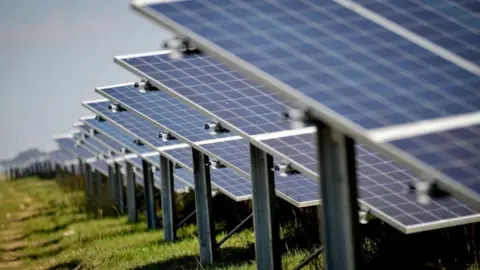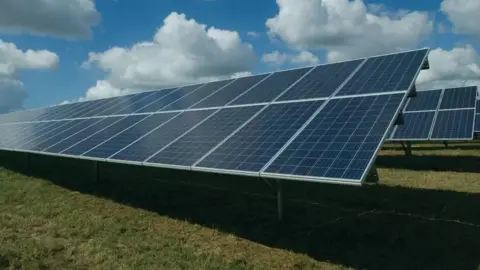Sunnica Energy Farm: What might a £600m solar farm mean for people nearby?
 PA Media
PA MediaTuesday marks the end of a six-month hearing into plans for what would be one of Europe's largest solar farms proposed on the Suffolk-Cambridgeshire border. What are the plans, what has been said during the planning hearing and what happens next?

The plans
The proposed energy farm would span about 2,500 acres around several villages in Suffolk and Cambridgeshire.
Called the Sunnica Energy Farm, the project has been put forward by Sunnica Limited, which claims the scheme would help meet the "national need for new, renewable means of energy".
The Sunnica Energy Farm would be split across three separate sites connected by underground cables to each other and to the National Grid at Burwell substation.
The sites are:
- Sunnica East Site A, near West Row and Mildenhall
- Sunnica East Site B, south of the village of Worlington
- Sunnica West Site A, near Newmarket north of the A14
The generating equipment will be fenced off and be monitored by CCTV.
Sunnica says the solar farm project would have a 40-year lifespan and the land used would be decontaminated and returned to its original (largely agricultural) use once the scheme is finished.
The company claims its solar farm will power 172,000 homes and create 1,500 jobs during construction. Once completed there would be 27 full-time jobs running the farm.
The scale of the project means it is classified as a Nationally Significant Infrastructure Project, which means the decision on whether it goes ahead will be taken by the government's Planning Inspectorate, rather than local planning officials.

Who is behind the project?
 Sunnica
SunnicaThe applicant for the solar farm is Aylesbury-based Sunnica Limited, a company formed in 2013 under a different name, Kestrel Meadow Limited.
Sunnica's majority shareholder is Jigg FM UK, which is jointly owned by Padero Solaer Limited and by Solaer UK Limited.
Jigg FM, Padero Solear and Solear are, in turn all owned by Los Dalton de Pozoseco S.L (LDP), a company formed in December 2022 in Spain.
LDP is owned by three Spanish firms - Bafi Genki, CECU Solar and Los Leandros Solares.
According to Sunnica's latest funding statement, money for Sunnica Solar Farm will come from LDP, which currently has assets of more than 17.9m euro (£15.7m).
It is understood more than £7m has already been spent on the project.
To meet the expected £600m overall scheme cost, LDP said it would "consult with a variety of financial institutions and investors to enable the construction, operation and maintenance" of Sunnica Energy Farm.

What do those involved say about the scheme?
 Shaun Whitmore/BBC
Shaun Whitmore/BBCVarious organisations, politicians and members of the community addressed the three-strong inquiry panel (called the examining authority).
Lucy Frazer KC, MP for South East Cambridgeshire, told the panel: "This application is over 2,500 acres and if permission is granted will be the largest solar farm in Europe."
"This land is farmland," she said, adding the solar farm would be "wholly out of character with what is there".
Race horse trainer Sir Mark Prescott said the solar farm presented "a challenge to Newmarket maintaining its rural aspect".
"We are the largest public gallops in the world," he said. "We have to ensure that our attraction remains as it is."
Paula McKenzie, of Worlington Parish Council, in Suffolk, said: "This proposal has already affected us and how we see where we live.
"I for one will not be staying in a village so dear to my heart if this application is passed. I'm not the only one to feel like this."
Dr Catherine Judkins, a member of the Say No to Sunnica group and Isleham resident, said: "Our landscape supports us, nurtures us and gives us our sense of place.
"The idea of so dramatically changing our rural outlook in one hit into an industrial outlook fills me with dread.
"It will damage our enjoyment of our surroundings and who we are as communities."
Sunnica spokesman Douglas Johnson said the firm remained "confident in the benefits of the scheme".
"If consented, it will make a significant contribution towards the country's need for more secure, affordable and sustainable energy supplies."
He said it would help the government meet its commitment to decarbonise the electricity system by 2035.
"Our choice of site followed a process that was informed by an appraisal of planning and environmental constraints and opportunities."
He said an environmental impact assessment had been carried out and said the design was developed with a "wide range of technical specialists" to minimise impact on the communities around it.
"We have conducted extensive public engagement, including two rounds of public consultation," he said.

What happens next?
The examining authority now has three months to prepare its report on the application.
The report will make a recommendation to Michael Gove, the Secretary of State for Housing, Communities and Local Government, on whether to approve or refuse the solar farm plan.
The secretary of state will then have three months to decide whether or not to grant permission.
That decision, however, might not be the end of the process.
Once Mr Gove makes his decision, there is a further six-week period during which it can be challenged in the High Court.

Find BBC News: East of England on Facebook, Instagram and Twitter. If you have a story suggestion email [email protected]
